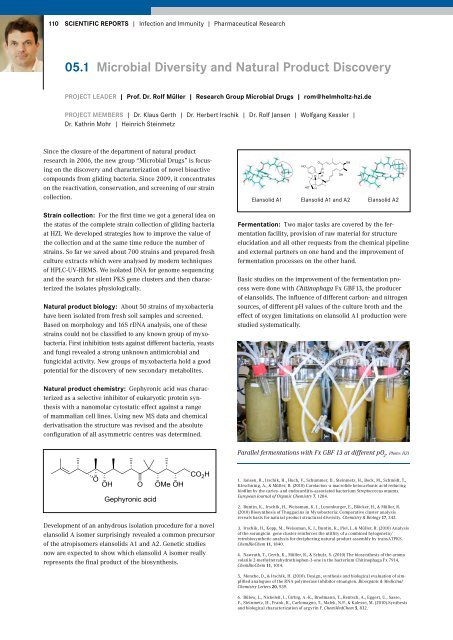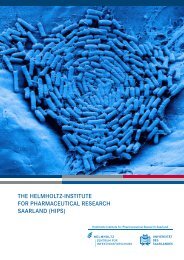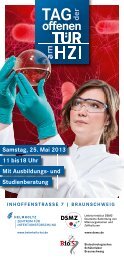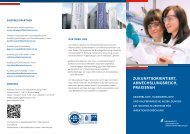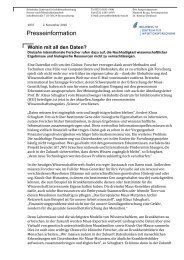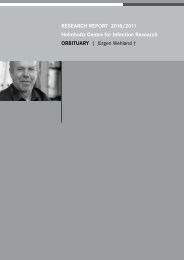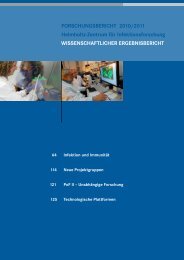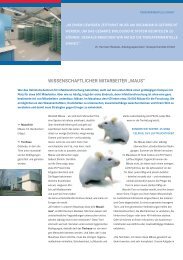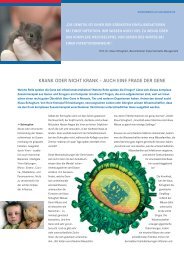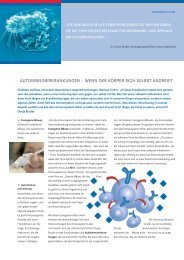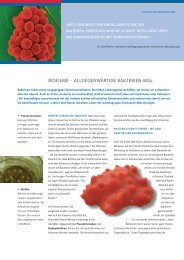Research Report 2010 2011 - Helmholtz-Zentrum für ...
Research Report 2010 2011 - Helmholtz-Zentrum für ...
Research Report 2010 2011 - Helmholtz-Zentrum für ...
Create successful ePaper yourself
Turn your PDF publications into a flip-book with our unique Google optimized e-Paper software.
110 SCIENTIFIC REPORTS | Infection and Immunity | Pharmaceutical <strong>Research</strong><br />
05.1 Microbial Diversity and Natural Product Discovery<br />
PROJECT LEADER | Prof. Dr. Rolf Müller | <strong>Research</strong> Group Microbial Drugs | rom@helmholtz-hzi.de<br />
PROJECT MEMBERS | Dr. Klaus Gerth | Dr. Herbert Irschik | Dr. Rolf Jansen | Wolfgang Kessler |<br />
Dr. Kathrin Mohr | Heinrich Steinmetz<br />
Since the closure of the department of natural product<br />
research in 2006, the new group “Microbial Drugs” is focusing<br />
on the discovery and characterization of novel bioactive<br />
compounds from gliding bacteria. Since 2009, it concentrates<br />
on the reactivation, conservation, and screening of our strain<br />
collection.<br />
Elansolid A1<br />
Elansolid A1 and A2<br />
Elansolid A2<br />
Strain collection: For the first time we got a general idea on<br />
the status of the complete strain collection of gliding bacteria<br />
at HZI. We developed strategies how to improve the value of<br />
the collection and at the same time reduce the number of<br />
strains. So far we saved about 700 strains and prepared fresh<br />
culture extracts which were analysed by modern techniques<br />
of HPLC-UV-HRMS. We isolated DNA for genome sequencing<br />
and the search for silent PKS gene clusters and then characterized<br />
the isolates physiologically.<br />
Natural product biology: About 50 strains of myxobacteria<br />
have been isolated from fresh soil samples and screened.<br />
Based on morphology and 16S rDNA analysis, one of these<br />
strains could not be classified to any known group of myxobacteria.<br />
First inhibition tests against different bacteria, yeasts<br />
and fungi revealed a strong unknown antimicrobial and<br />
fungicidal activity. New groups of myxobacteria hold a good<br />
potential for the discovery of new secondary metabolites.<br />
Fermentation: Two major tasks are covered by the fermentation<br />
facility, provision of raw material for structure<br />
elucidation and all other requests from the chemical pipeline<br />
and external partners on one hand and the improvement of<br />
fermentation processes on the other hand.<br />
Basic studies on the improvement of the fermentation process<br />
were done with Chitinophaga Fx GBF13, the producer<br />
of elansolids. The influence of different carbon- and nitrogen<br />
sources, of different pH values of the culture broth and the<br />
effect of oxygen limitations on elansolid A1 production were<br />
studied systematically.<br />
Natural product chemistry: Gephyronic acid was characterized<br />
as a selective inhibitor of eukaryotic protein synthesis<br />
with a nanomolar cytostatic effect against a range<br />
of mammalian cell lines. Using new MS data and chemical<br />
derivatisation the structure was revised and the absolute<br />
configuration of all asymmetric centres was determined.<br />
Parallel fermentations with Fx GBF 13 at different pO 2<br />
. Photo: HZI<br />
1. Jansen, R., Irschik, H., Huch, V., Schummer, D., Steinmetz, H., Bock, M., Schmidt, T.,<br />
Kirschning, A., & Müller, R. (<strong>2010</strong>) Carolacton -a macrolide ketocarbonic acid reducing<br />
biofilm by the caries- and endocarditis-associated bacterium Streptococcus mutans.<br />
European Journal of Organic Chemistry 7, 1284.<br />
Development of an anhydrous isolation procedure for a novel<br />
elansolid A isomer surprisingly revealed a common precursor<br />
of the atropisomers elansolids A1 and A2. Genetic studies<br />
now are expected to show which elansolid A isomer really<br />
represents the final product of the biosynthesis.<br />
2. Buntin, K., Irschik, H., Weissman, K. J., Luxenburger, E., Blöcker, H., & Müller, R.<br />
(<strong>2010</strong>) Biosynthesis of Thuggacins in Myxobacteria: Comparative cluster analysis<br />
reveals basis for natural product structural diversity. Chemistry & Biology 17, 342.<br />
3. Irschik, H., Kopp, M., Weissman, K. J., Buntin, K., Piel, J., & Müller, R. (<strong>2010</strong>) Analysis<br />
of the sorangicin gene cluster reinforces the utitlity of a combined hylogenetic/<br />
retrobiosynthetic analysis for deciphering natural product assembly by transATPKS.<br />
ChemBioChem 11, 1840.<br />
4. Nawrath, T., Gerth, K., Müller, R., & Schulz, S. (<strong>2010</strong>) The biosynthesis of the aroma<br />
volatile 2-methyltetrahydrothiophen-3-one in the bacterium Chitinophaga Fx 7914.<br />
ChemBioChem 11, 1014.<br />
5. Menche, D., & Irschik, H. (<strong>2010</strong>). Design, synthesis and biological evaluation of simplified<br />
analogues of the RNA polymerase inhibitor etnangien. Bioorganic & Medicinal<br />
Chemistry Letters 20, 939.<br />
6. Bü low, L ., Nickeleit, I., Gi rbig, A .- K ., Brod ma n n, T., Rentsch, A ., Egger t, U., Sasse,<br />
F., Steinmetz, H., Frank, R., Carlomagno, T., Malek, N.P., & Kalesse, M. (<strong>2010</strong>).Synthesis<br />
and biological characterization of argyrin F. ChemMedChem 5, 832.


